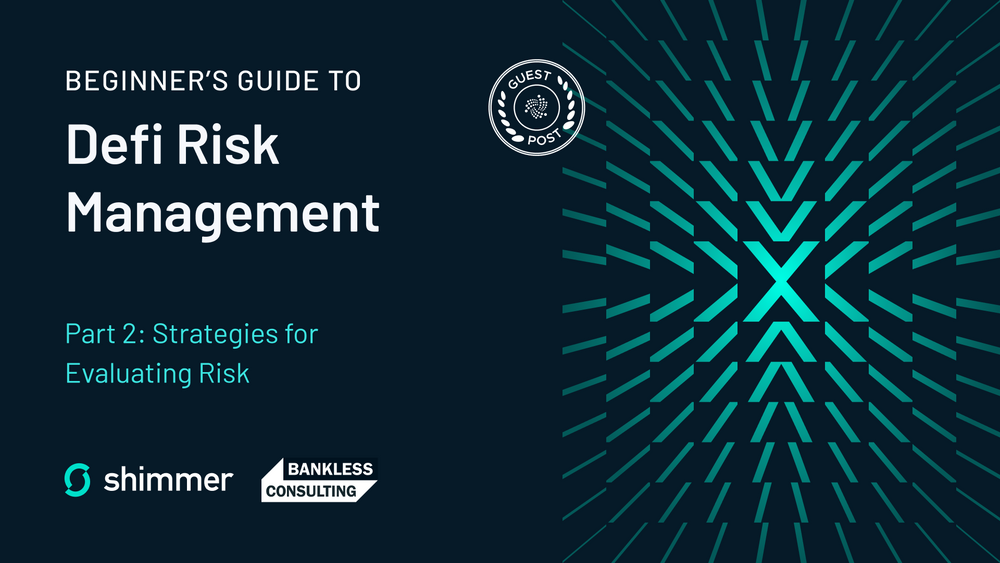Beginner’s Guide to DeFi Risk Management Part 2
Strategies for Evaluating Risk
TL;DR:
The second part of our guide to DeFi risk management explores strategies to evaluate risks associated with tokens. It discusses the Lindy Effect, which suggests that the longer a smart contract remains unexploited, the less likely it is to be exploited in the future, though not guaranteed. Factors such as Total Value Locked and team experience must also be considered. It emphasizes evaluating opportunities realistically, distinguishing between token value and price, and scrutinizing tokenomics, team dynamics, liquidity concerns, and yield sources.
After categorizing risks, navigating them carefully is essential. Various strategies aid in evaluating token-associated risks.
Please note that this guide applies to all manner of tokens in the crypto space, including security, currency, and utility tokens.
The Lindy Effect
Based on survivorship bias, the Lindy Effect states that the longer a smart contract or platform remains unexploited, the greater the likelihood it will remain unexploited in the near future.
However, this doesn’t guarantee immunity from exploitation. Correlating this metric with Total Value Locked (TVL) is crucial. Protocols with low TVL may not be lucrative targets for hackers, as exploitation depends on discoverability and incentive.
Key Considerations for Evaluating Risks
When evaluating risks, key considerations also include the age of the contract, the team’s experience, and any history of contract exploitation on the same or previous platforms.
Notably, a team with a track record of multiple contract exploitations on a single platform raises a big red flag, suggesting a heightened risk of continued exploitation, even if the team has reimbursed affected users.
Contract Upgrade Monitoring
Assessing mechanisms for monitoring contract upgrades is also crucial. Contract upgrades can reset the Lindy Effect, so being informed about them is crucial. For example, if a contract upgrade has a 48-hour window before taking effect, consider temporarily withdrawing funds from the platform to observe the post-upgrade scenario. These risk mitigation actions complement non-monetary strategies.
Although assigning exact numbers might be challenging, the key lies in acknowledging that there exists a probability associated with each action as well as an expected benefit.
Evaluating Opportunities
When evaluating an opportunity, it is essential to realistically assess what is known and quantifiable in terms of risks. While acknowledging the existence of smaller, unquantifiable tail risks, such as regulatory uncertainties or geopolitical conflicts, focus on larger, systemic impacts of these potential threats on the economy and the subsequent implications for any investments or platforms you might be considering.
In essence, we are engaged in a strategic battle against uncertainty, striving to tilt the odds in our favor by conducting a sober assessment of the benefits while mitigating the quantifiable risks. The guiding principle is to ensure that the cost of risk mitigation remains proportionate to the benefits derived from such measures. For instance, when insuring a million-dollar house, the choice of an insurance policy should align with the expected loss of the property. In what time frame will the premiums exceed the payout of the policy, and does this time horizon align with your goals?

Furthermore, it’s crucial to recognize that a token — be it a utility token, governance token, NFT, etc. — represents a bundle of rights, liabilities, and risks. Mentally cataloging this bundle is imperative for comprehending not only what is gained but also the potential risks associated with changes in value. For example, a governance token may provide a voice in a community, offering value beyond financial gain. However, it may also carry risks, such as a slashing risk, where voting in a particular way could lead to a reduction in tokens held.
A multifaceted evaluation should go well beyond pure monetary considerations.
Token Value vs. Token Price
When evaluating opportunities, it’s important not to conflate token price with token value. As just mentioned, tokens can be thought of as a bundle of different rights within a protocol, and these rights form the basis of the token’s value, independent of price. Many factors can influence the token’s price without necessarily affecting its overall value. For instance, an inflationary token designed to distribute property rights among token holders may change the allocation proportions without a direct influence on the price of the token. Therefore, it’s imperative to scrutinize the true nature of the token to understand how it might be diluted over time.
It goes without saying that the ‘number doesn’t always go up,’ particularly in crypto winters. As highlighted earlier, value is not synonymous with token price; rather, value is a more nuanced consideration. This brings us to the core principle of your investigation: identify platforms that generate more value than the resources they consume. Identifying a platform that efficiently creates substantial value could be a positive indicator, especially if it utilizes its resources efficiently. And while true value can be tough to pin down, a platform whose expenditures surpass its revenues is a red flag in need of further scrutiny. Aligning your holding timeframe with the platform’s ability to generate value is crucial.
Bootstrapping a project through a mechanism that encourages support for the token is a common approach for many platforms. However, this method essentially involves exchanging a different valuable asset for the platform’s token or NFT, with the expectation that the platform will utilize that valuable asset efficiently, preserving the value of the medium of exchange. Ideally, the token should contribute to meaningful outcomes, such as the creation of art, robust community infrastructure, and more. In evaluating a project, the focus should be on identifying the value being generated. A lack of discernible value is another red flag and may indicate potential shortcomings or a lack of substance in the project.
Specific Tokenomics-Related Considerations
Can tokens be minted indefinitely? Is there a controlled minting function? Access to information such as burn rates through tools like a Dune dashboard is valuable for assessing a platform’s financial health. Understanding how the supply changes over time affects the proportion of long-term ownership on the platform.
The Team
The team behind the token also deserves scrutiny. Delve into their vesting schedule, particularly if they have immediate unlocks or if their unlocks precede those of other project supporters. Also, identify who has the authority to mint tokens (if possible) and their incentives regarding supply release or reduction. This is crucial in evaluating whether the current token price accurately reflects the expected benefits and risks associated with the platform and can help you avoid pronounced sell-offs when tokens are released to other protocol participants.
Liquidity Concerns
Critical to this evaluation is an examination of the treasury’s status. In the event of a sudden decline in the native token’s value, the platform’s ability to meet financial obligations becomes pivotal. Understand the potential consequences of a fall in value, such as a liquidation cascade, and its impact on market liquidity. Assessing whether the treasury can sustain payments or faces a liquidity crunch is a crucial aspect of risk assessment. Evaluating whether the platform is profitable, approaching profitability, or experiencing escalating losses is integral to this analysis.
Addressing liquidity risk is essential in evaluating the ability to exit a position, particularly concerning unlock schedules. Consider a scenario where you’ve locked your tokens for a year, but a significant portion controlled by VCs unlocks in six months. Assessing whether these stakeholders are incentivized to hold or dump their tokens on the market is important. The impact on pricing and the platform’s ability to convey its valuation to the market before unlocking can affect your exit strategy. Knowledge of these schedules relative to exit possibilities is paramount, as higher exit barriers correspond to increased risk if alternative hedges are not employed.
Yield
When considering yield, an analysis of the source of value paying for the yield is fundamental. Distinguishing whether the yield comes from token minting or actual value creation aids in comprehending the platform’s mechanics. Understanding the source of yield helps to assess whether the token’s current price aligns with its intrinsic value and where the price might stabilize in the long term.
Imagine a project offering a high 115% APY. Why does the market demand such a high APY and what justifies it? Delving into the background can reveal if risks are simply offloaded to token holders to justify the APY, or perhaps it serves as an incentive to hold an inflationary token. Scrutinizing the sustainability of this yield and the potential for the token’s price to decline substantially is crucial. The mantra ‘there’s no such thing as a free lunch’ applies here, urging a thoughtful examination of the market dynamics and one’s assumptions when lured in by high yields.
More information regarding Yield can be found in the Shimmer DeFi Education Series blog post on the same subject.
Deciphering DeFi Risks: What's Next?
In conclusion, navigating through DeFi risks requires careful consideration and evaluation. Key strategies include understanding the Lindy Effect, assessing token-associated risks, and scrutinizing factors like contract age, team experience, and liquidity concerns. Additionally, distinguishing between token value and price, and evaluating liquidity concerns, yield, and the project's team are crucial steps.
Beyond these essential factors, it’s important to take a longer view of a project’s roadmap and analytics - even to the point of conducting an audit. We explore these in the next and final part of this guide – stay tuned!
Beginner’s Guide to DeFi Risk Management
Understanding Risk & Uncertainty
Strategies for Evaluating Risk
Roadmaps, Analytics, and Economic Audits
Also in this series
Beginner's Guide to Crypto Wallets
Beginners Guide to DEX vs. CEX
Beginner's Guide to DeFi Lending & Borrowing
Beginner's Guide to Yield Farming
Beginner's Guide to Governance
